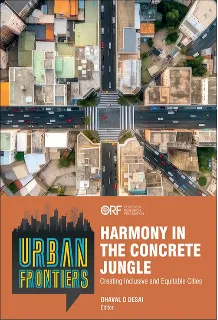Editor’s Note
Globalisation has driven nations to create and mould cities using a singular development template. Cities are largely being visualised as spaces with high-end, gated residential townships and sparkling business districts, with a peppering of supposedly ‘open and green’ public spaces that end up catering only to the top tiers of the social and economic strata.[1] These urban agglomerations are energy-intensive and exploit natural resources with abandon, encouraging unsustainable consumption patterns and leading to vast socioeconomic disparities and increasing climate vulnerability.
This elitist trend has displaced the urban poor and widened socioeconomic gaps. The redevelopment of the mill lands in Central Mumbai throughout the 1990s, for one,[2] bears testimony to how the poor and labour class can often be very easily relegated to the margins as political leaders and planners aim for their “world-class, slum-free city”.[3] In Mumbai, this paradigm led to socioeconomic segregation, seen in the rise and spread of sprawling informal neighbourhoods. The poor and the marginalised were pushed further into the margins, mainly in the slums in unsafe, unhealthy, and often isolated surroundings, enduring poor quality of life.[4]
Globally, statistics would prove this uncomfortable truth: approximately 1.2 billion of the urban population live in slums or slum-like conditions; their number is likely to double by 2050.[5] This phenomenon is expected to be witnessed as the existing urban agglomerations expand further and new urban spaces are created in the emerging economies of the Global South. Nearly 50 percent of India’s total urban population live in informal settlements. The situation is no better in most developing nations in Asia and Africa,[6] indicating a striking similarity across cultural and political systems.
This is not to say that cities in the developed world are socially just and inclusive. Indeed, some of these cities are experiencing increasing incidence of homelessness—which would be indicative that there are many who are being left behind. Studies in these countries have found not just a shortage of housing but a myriad of social factors, including eroding societal values, collapsing family relationships, and increasing drug addiction and alcoholism as primary factors contributing to homelessness.[7],[8] Compared to emerging economies, however, these Western cities do not have to serve the needs of massive population densities. They also have adequate financial resources to bring about remedial measures.
Inclusion goes beyond accounting for and delivering access and equity to the poor. Shaping their notions of an “urban life”, cities have historically neglected the specific needs of women, gender minorities, children, people with disabilities, and the older adult populations. This phenomenon is witnessed in the low workforce participation rates of women, non-participatory city planning and governance mechanisms, the lack of safe public spaces and transport, and poor access to healthcare, water and sanitation. Research suggests that the onset of the digital age has further widened many of these disparities.[9]
The UN-Habitat’s World Cities Report 2022[10] aptly captures the above realities. Recognising the role of urbanisation in the long-term prosperity of the people and the planet, its New Urban Agenda[11] adopts an optimistic vision of ‘cities for all’ and provides guidelines for inclusive and equitable urban futures. It charts a people-first development roadmap to create gender-responsive cities, enhance social security, equity and justice, and participatory city planning and governance.
Given the existing scenario, achieving such an ambition will be a complex and challenging task. Unless backed by firm commitments and bold, transformative action from global, regional, national and local leaderships, this so-called ‘inclusive’ vision could yet become an epitaph of urban evolution in the 21st century.
This anthology, Harmony in the Concrete Jungle: Creating Inclusive and Equitable Cities, thus comes at a critical time. It underscores the belief that the strength of cities is woven into the inclusive fabric. The contributors to this compendium are catalysts for change. In their essays, they offer a medley of insights, ideas, strategies and case studies that will inform future policy and action. They draw from diverse disciplines, bridging the realms of academics, policymaking, and grassroots interventions to present a holistic perspective on the imperative of nurturing inclusive cities. These essays not just reflect on the wrongs of the past but serve as beacons of hope for truly inclusive urban futures. They delve into the intricate tapestry of challenges and opportunities that define the quest for inclusive cities.
Each essay underlines the power of transformative thinking and collective action: how future urban development must consider ever-evolving cultural, socioeconomic, generational and gender diversities; how ‘smart’ cities must ensure that technology works for all; ‘empowered urbanism’ frameworks and the role of open and green spaces in fostering inclusive and safe cities; the critical role of traditional knowledge systems and experiences; gender budgeting; the importance of civil society organisations in promoting inclusive urban spaces; advancing women in leadership roles and people-centric placemaking interventions; and deliberating pathways for the convergence of inclusive and climate-resilience strategies and multi-stakeholder engagement.
Inclusive cities are not just a moral imperative but a strategic investment in a brighter and more sustainable future. It is our hope that this effort aids and catalyses efforts in designing cities of the future that embrace diversity, promote equity, and foster a sense of belonging among all urban stakeholders.
Read the volume here.
[1] Nilsen Ariel Espino, Building the Inclusive City: Theory and Practice of Confronting Urban Segregation (New York: Routledge, 2015), pp. 3-4
[2] Anupama Katakam, “Vanishing mill lands,” Frontline, September 23, 2005, https://frontline.thehindu.com/other/article30206371.ece
[3] Shirish Patel, “Slum Rehabilitation: 40 Lakh Free Lunches?,” Economic and Political Weekly 30 (1995): 2473-2476.
[4] Espino, Building the Inclusive City: Theory and Practice of Confronting Urban Segregation
[5] United Nations, The Sustainable Development Goals Report 2023: Special Edition, New York, United Nations, 2023.
[6] World Bank, “Population living in slums (% of urban population),” World Bank Group.
[7] M A Mabhala, A Yohannes and M Griffith, “Social conditions of becoming homelessness: Qualitative analysis of life stories of homeless peoples,” International Journal for Equity in Health, 16, 150 (2017).
[8] Heather Mac Donald, “San Francisco, Hostage to the Homeless,” City Journal, Autumn 2019.
[9] Foley Rider W et al., “Towards Digital Segregation? Problematizing the Haves and Have Nots in the Smart City,” Frontiers in Sustainable Cities, Volume 4 (2022).
[10] UN-Habitat, World Cities Report 2022: Envisaging the Future of Cities, Nairobi, United Nations World Habitat Programme, 2022.
[11] United Nations, New Urban Agenda, New York, United Nations, 2017.
The views expressed above belong to the author(s). ORF research and analyses now available on Telegram! Click here to access our curated content — blogs, longforms and interviews.

 PDF Download
PDF Download



 PREV
PREV


